Declining insect populations at various locations across the planet have been described by scientists (Goulson, D., Current Biology, v 29, I 19, Oct. 7, 2019) and documented by citizens’ observations (Footnote #1).
These losses have adversely impacted our insect allies.
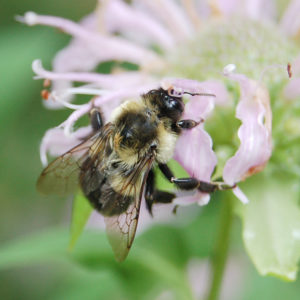 At least four U.S. bumble bee species have been reported to be in decline in abundance and range. (DoD Pollinator Conservation Reference Guide, Sept 2018, p. 65)
At least four U.S. bumble bee species have been reported to be in decline in abundance and range. (DoD Pollinator Conservation Reference Guide, Sept 2018, p. 65)
In New Hampshire, researchers found a dramatic decline of 14 wild bee species important across the Northeast for pollination of apples, blueberries and cranberries. These species, declining in the seacoast areas but persisting in the higher elevation mountainous areas, appear to be indicators of climate change adversely affecting certain native wild bees. (unhtoday/news/April 2019)
A study of insect losses in Britain between 1980 and 2013 found that for wild pollinator species a third (33%) decreased over this period. (Powney, G.D., et al, “Widespread losses of pollinating insects in Britain,” Nature Communications, March 26, 2019)
Measurements of the total flying insect biomass between 1989 and 2016 in Germany (over 27 years) estimated a decline of 76% (Hallman, C.A., PLoS ONE, 12, e0185809 (2017)
“Populations of European grassland butterflies are estimated to have declined by 50% in abundance between 1990 and 2011.” (Hallman, C.A., PLoS ONE, 12, e0185809 (2017)
These declines should concern us.
“…Much can be done to bring about [insect] recovery….” (The Wildlife Trusts, “Reversing the Decline of Insects”)
We humans can promote awareness of insect importance, and acknowledge that we, perhaps without meaning to, have contributed to insect declines. Finally we can adopt lifestyle changes to offset past and present conditions associated with damage to our insect allies.
Valuing Insects
E.O. Wilson once said, “Without insects the environment would collapse into chaos.” (The Wildlife Trusts, “Reversing the Decline of Insects”)
Concerning insects Rachel Carson wrote, ”The terrible danger is that we have underestimated their value…” She described our “insect allies” as being found, “Everywhere, in field, and hedgerow, and garden, and forest…above a pond the dragonflies capture mosquitoes in the air…in the waters below their young …prey on aquatic stages of the mosquitoes…Some… [insects] are exceedingly minute wasps, yet by their numbers and their great activity they hold down the abundance of many crop-destroying species” (Silent Spring p. 251)
Essential services originating with insects include: pollinating wild flowers and crops, recycling nutrients, aerating the soil, aiding in decomposition, (Footnote #2) helping to control pests and serving as food for other species (such as birds, bats, fish, reptiles and amphibians).
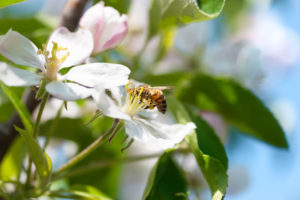 Three quarters (¾) of crops grown by humans require pollination by insects (honey bees, wild bees and other insects). This service is estimated to be worth between $235-577 billion per year, worldwide. (The Wildlife Trusts “Reversing the Decline of Insects”)
Three quarters (¾) of crops grown by humans require pollination by insects (honey bees, wild bees and other insects). This service is estimated to be worth between $235-577 billion per year, worldwide. (The Wildlife Trusts “Reversing the Decline of Insects”)
“Bees are our most important agricultural animals. Without bees, the whole thing falls apart,” according to veterinarian, Dr. Tracy Farone. (JAVMA , August 1, 2020)
Dr. Ryan Kane, a veterinarian noted that bees “make our systems work” and their health needs greater protection for food security and other reasons. (JAVMA , August 1, 2020)
Human Involvement in Insect Declines
In 1962 when Silent Spring was published Rachel Carson warned Americans that, “We have turned our artillery [hazardous chemical pesticides] against our [insect] friends.” In 2020, 58 years later, chemical pesticides remain prominent in agriculture, horticulture and elsewhere. They are associated with adverse effects for insects.(footnote-#3) For example, neonicotinoids, currently some of the most widely used insecticides have been found harmful to bees and other beneficial insects.
Another driver of insect losses has been the removal of essential insect habitat – including the fields, forests, and wild lands claimed by humans for industrial agriculture or development.
In addition, the growing level of CO2 in the atmosphere has been linked to altered food sources as well as environmental conditions needed by pollinators.
Climate Change and Bee Nutrition
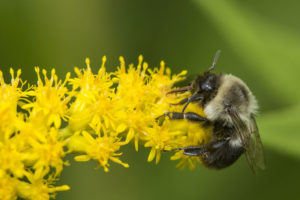 In Silent Spring Rachel Carson wrote: “Honeybees and wild bees depend heavily on such “weeds” as goldenrod, mustard and dandelions for pollen that serves as the food for their young.” Scientists have found a clear link between rising atmospheric carbon dioxide and a qualitative decline in pollen protein for the goldenrod species Solidago canadensis, “among the most widely recognized and widely available food source for bees in North America.” Lower pollen quality has been shown to negatively impact adult longevity in bees in a number of studies (Ziska, L., et al, “Rising atmospheric CO2 is reducing the protein concentration in a floral pollen source essential for North American bees,” Proceedings of the Royal Society B, Biological Sciences, April 13, 2016)
In Silent Spring Rachel Carson wrote: “Honeybees and wild bees depend heavily on such “weeds” as goldenrod, mustard and dandelions for pollen that serves as the food for their young.” Scientists have found a clear link between rising atmospheric carbon dioxide and a qualitative decline in pollen protein for the goldenrod species Solidago canadensis, “among the most widely recognized and widely available food source for bees in North America.” Lower pollen quality has been shown to negatively impact adult longevity in bees in a number of studies (Ziska, L., et al, “Rising atmospheric CO2 is reducing the protein concentration in a floral pollen source essential for North American bees,” Proceedings of the Royal Society B, Biological Sciences, April 13, 2016)
Increasing atmospheric carbon dioxide has been associated with lower amounts of zinc in plant tissue. (Beach, R. H., et al, Lancet Planet Health, 2019) Zinc nutrition increases the antioxidant defenses of honeybees. (Zhang, G., et al Entomol. Exp. Appl., 156:201-210, 2015)
More research needs to take place on the impact of reduced plant zinc and protein in pollen for bees.
Confronting and Reversing Insect Decline
Rachel Carson expressed her hope for a future without the routine use of hazardous chemical pesticides to deal with unwanted species. In “A New Chapter to Silent Spring” she wrote: “It will take time to revolutionize our methods of insect and weed control to the point where dangerous chemicals are minimized.” (first published in the Bulletin of the Garden Club of America, May 1963)
Government Actions
In Amsterdam, a ban on pesticides for use on public land and a municipal plan to convert half of the green space to native flowers along with a grassroots campaign to grow flowering plants and put bee hotels in private gardens has led to an increase in bee diversity by 45% since 2000. (The Wildlife Trusts “Reversing the Decline of Insects”)
As of September 2019 the French cities of Paris, Lille, Nantes, Grenoble and Clermont-Ferrand have banned pesticides to safeguard biodiversity and public health. (Bottollier-Depois, A., Byme,C., in Paris)
In Copenhagen, Vancouver, Toronto and Barcelona pesticide bans have been introduced. (The Wildlife Trusts “Reversing the Decline of Insects”)
“in Bavaria… triggered by studies revealing dramatic declines in German insect populations, in 2019 nearly two million people… signed a petition to save the insects, forcing the state to fund a sweeping package of actions to reverse the declines.” (The Wildlife Trusts “Reversing the Decline of Insects”)
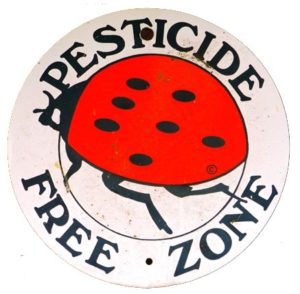 Montgomery County, Maryland with its Healthy Lawns Act has introduced legislation to reduce hazardous chemical pesticide use. Since May 2019 products containing chemical pesticides associated with harm to family members, pets, pollinators and the environment including “weed and feed” products are banned for cosmetic use on residential lawns in Montgomery County. The Healthy Lawns Act was upheld in court, following a legal challenge from pesticide interests. The County government encourages home owners to use organic lawn care.
Montgomery County, Maryland with its Healthy Lawns Act has introduced legislation to reduce hazardous chemical pesticide use. Since May 2019 products containing chemical pesticides associated with harm to family members, pets, pollinators and the environment including “weed and feed” products are banned for cosmetic use on residential lawns in Montgomery County. The Healthy Lawns Act was upheld in court, following a legal challenge from pesticide interests. The County government encourages home owners to use organic lawn care.
Legislation banning pesticide use was passed in the city of Takoma Park as well as in Portland, Maine.
To facilitate successful pollinator conservation, a US Department of Defense document advises: “Eliminate the use of pesticides when possible.” (DoD Pollinator Conservation Reference Guide, Sept 2018, p. 92)
Agricultural Actions
Regenerative farming represents a revolutionary way of insect and weed control. Once adopted, regenerative agriculture can greatly reduce the need for dangerous chemical pesticides. It is a system based upon working with, not against nature. Farmers themselves are reported to find regenerative agriculture appealing. (Crable, A., “Soil health practices increasingly helping farmers hit pay dirt,” Chesapeake Bay Journal, June 2020)
Pioneering farmers have been holding field demonstrations where they share details about the three main components of regenerative agriculture: no-till planting practices, growing cover crops to suppress weeds and use of natural fertilizer that can lead to healthier soil and to crops that resist pest pressure while allowing natural enemies of pests to thrive. (Crable, A., “Soil health practices increasingly helping farmers hit pay dirt,” Chesapeake Bay Journal, June 2020)
More research is needed to identify how regenerative farming can be used under various growing conditions.
Protecting Ourselves and Our Insect Allies
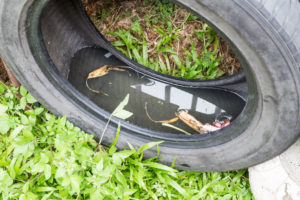 During these late summer days we are reminded that not all insects are friendly. When dealing with mosquitoes, ticks, and other enemies we can wear protective clothing, apply low risk insect repellants to our skin, and help prevent our insect enemies from having access to our surroundings by removing places where they reproduce (for mosquitoes it’s standing water, for ticks it’s leaf litter, tall grass and mouse nests). We need to avoid broadcast spraying of hazardous chemical insecticides especially on our residential landscapes and wild habitats to prevent our insect allies from being exposed to dangerous pesticides even as we try to protect ourselves from insect species that could harm us.
During these late summer days we are reminded that not all insects are friendly. When dealing with mosquitoes, ticks, and other enemies we can wear protective clothing, apply low risk insect repellants to our skin, and help prevent our insect enemies from having access to our surroundings by removing places where they reproduce (for mosquitoes it’s standing water, for ticks it’s leaf litter, tall grass and mouse nests). We need to avoid broadcast spraying of hazardous chemical insecticides especially on our residential landscapes and wild habitats to prevent our insect allies from being exposed to dangerous pesticides even as we try to protect ourselves from insect species that could harm us.
Individual Actions
By speaking out about insect services, you can help make certain that legislators, teachers, students, gardeners, and public health professionals are aware of the value of: insect pollinators, pest controlling beneficial wasps, ladybugs, lacewings, and dragonflies among others.
You can support making a place for pollinators where you live, work, play and worship.
You can recommend eliminating the use of chemical pesticides when possible as suggested by the USA DoD Guidance for Pollinator Conservation.
You can support providing a wide selection of plants for pollinators from spring to fall. It is especially important to have goldenrod in late summer and into the autumn to make certain the bees have protein that is found in the pollen of the goldenrod species (such as Solidago canadensis and other Solidago spp)
To help make certain that the harmful effects of increasing carbon dioxide on goldenrod pollen does not present a hazard to bees and for many other reasons, you can support actions reducing reliance on fossil fuels
 You can decide to purchase food grown with organic and/or regenerative methods.
You can decide to purchase food grown with organic and/or regenerative methods.
You can encourage individuals of different generations, adults and young people to share the sense of wonder for the various insect life forms and the many ways that they provide essential services and help to create a winning entry for RCLA’s Wonder Contest. Click here to see details of the RCLA’s Wonder Contest.
An entry for the 2020 Intergenerational Sense of Wonder/Sense of the Wild Contest shows how a young person could feel empathy for a caterpillar. More about this soon.
You can explore different ways of regarding insects and other animals. One of Rachel Carson’s favorite writers, Henry Beston, offers a way of considering our relationship with animals. In his book, The Outermost House he counsels:
“We need another…concept of animals. We patronize them for their incompleteness…And therein we err, and greatly err. For the animal shall not be measured by man…They are not brethren, they are not underlings; they are other nations, caught with ourselves in the net of life and time, fellow prisoners of the splendor and travail of the earth.”
The loss of insects, especially our insect allies, can serve as a wake-up call for ordinary citizens as well as those in power to commit to mitigating the decline not only of insects but also biodiversity worldwide. As one of the most important elections approaches voters in the US need to consider which party has the most long-term plan for the nation that will assure protection of its precious biological resources.
Diana Post, President Rachel Carson Landmark Alliance, 8-31-20
Footnotes:
Footnote #1: Adults remember when as children going on summer vacation car trips the windshield became covered with so many bug bodies that it had to be cleaned regularly. This is no longer a problem as has been confirmed by recent `splatometer’ tests revealing a huge decline in insect numbers. Finally, when splatometer tests of vintage cars and current models were compared to see if aerodynamic designs contributed to a lower windshield bug count, it was “found that the modern cars actually hit slightly more insects.” (Carrington, D., The Guardian Feb 17, 2020).
Footnote #2: “Insects play an important role in the decomposition and recycling of excrement…This was convincingly demonstrated when cattle were brought to Australia in the eighteenth century, Because Australian dung beetles were not capable of coping with the wet sloppy droppings of cows, dung accumulated in pastures, smothering the growth of plants. But when the proper dung beetles were imported from Europe and Africa, the problem was largely solved.” (Waldbauer, G., What Good Are Bugs?: Insects in the Web of Life, 2003, Harvard University Press)
Footnote #3 Pesticides Harm for Insects
“Pesticides (including insecticides, herbicides and fungicides…) can kill more than the target pest and are one of multiple factors contributing to the decline of native pollinators and honey bees. Some ways insecticides and some herbicides can harm pollinators are by killing them, delaying development, reducing reproduction, and affecting the ability to forage and navigate. Pesticide residues can remain in the environment and be effective on targeted and non-targeted animals for days after it is applied. They can be absorbed and transported to plant parts including leaves nectar and pollen and even exuded as droplets by plants. Pollinators can ingest the pesticides by eating plant parts or drinking the liquid exuded by the plant…”
“Herbicides can indirectly harm pollinators by eliminating their food source. They can also disrupt the balance of predators and parasites that naturally regulate pest problems. Pest problems can increase when pesticides are used if the pesticide kills natural predators (e.g. beneficial insects) along with the target pest, or if the target pest develops resistance to the pesticide…”
(DoD Pollinator Conservation Reference Guide, Section 3, “Adverse Impacts of Pest Control”, p. 92, September 2018).

